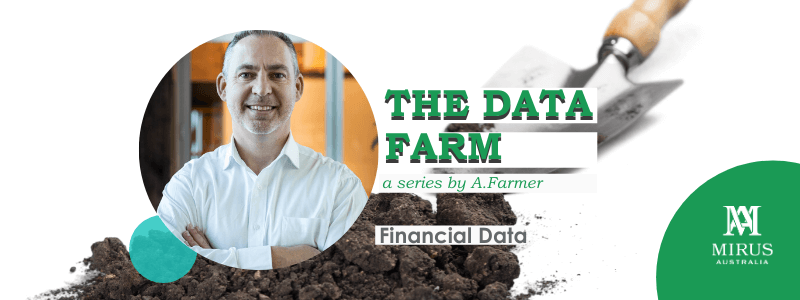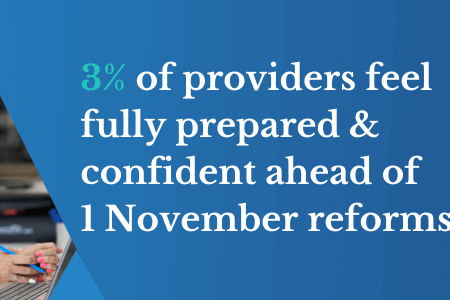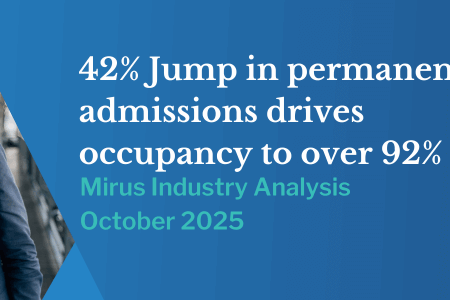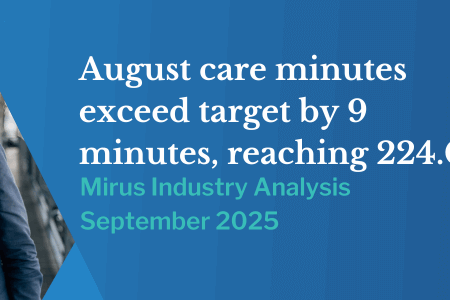The Data Farm Series with A Farmer: Financial Data
June 3, 2020 | Aged Care Management

“I have been fascinated by the interest, impact and importance of data. Around the world.
There is a recognised cliché in scientific circles which says “In God we trust, others must provide data.” Our world’s governments and organisations such as the World Health Organisation have been desperate to gather data, analyse and model it in the hope of finding answers or at least to support their decision making and preferably in real-time.” A Farmer, The Data Farm Series.
This is the 4th post in a series from a presentation I gave at the ITAC2020 conference in March.
In the first instalment, we thought about a simple model that helps to explain the importance of building activities into systems and structuring the data well in order to produce the reporting (insights) the business needs.
In the second instalment, we looked at the potential and limitations that clinical data has for the industry. On the one hand, it is a core system that has been capturing data for a long time. On the other hand, there is an interesting conundrum that a system is limited by its purpose because that drives the data it collects and therefore the insight it can produce.
In the third instalment, we discussed customer data and how it is developing rapidly in the aged care industry from necessity but also as an example of how the industry is maturing.
In this post, we look at financial data, the last of the three (3) core types of data in Aged Care which are Clinical, Customer and Financial data.
The financial data and in particular Medicare and Workforce related data are a core focus of Mirus’ business. Since the beginning of ACFI and more recently with our workforce product, we have spent many years understanding the data available.
Medicare data in particular is the closest thing to “big data” that the Aged Care industry can claim. Data points across more than two hundred thousand residents are submitted daily. At Mirus, we have coverage of more than a third of these residents with a total approaching 75,000 beds and we can see amazing things in this data.
What are some of the opportunities and the pitfalls in using this “big data”?
One of the key limitations in the data is the industry’s widespread dependence on averages or aggregates. The most common of these is Average Daily Subsidy (ADS) and Occupancy. These are two (2) very important indicators of financial performance in most Aged Care businesses. The challenge is that although these measures are relatively easy to track, they are much more difficult to change because they are both affected by the average impact of a number of different factors. Further, they also impact each other.
In the case of ADS, the increasing difficulty in finding enough suitable residents at high acuity will sometimes determine whether ADS ‘suffers’ to increase occupancy or vice versa. For ADS, this is usually the impact of new vs departed. That is, the ACFI for a new resident is usually lower due to lower acuity than a departing resident but by how much is the critical factor. For occupancy it relates to the higher ACFI and therefore acuity of the residents brought into the facility, the shorter the turnover time and the need to then replace that resident sooner. For many in the industry, higher acuity residents are amongst over 30% of residents who depart with 6 months. So many organisations at present are trying to fill their facilities to improve financial performance, trying to manage higher acuity residents and are therefore also needing to replace those residents more quickly, which puts an ever increasing challenge on an organisation that traditionally didn’t have this problem.
Now some of the opportunities.
The good news is that managing your data and driving your business forward can be simplified. We like to talk about the profit or value equation. As complex as an Aged Care business can be and at the risk of oversimplifying as stated above, there are three (3) components to focus on.
- Profit (value created) = Revenue – Costs
- Fortunately for Aged Care, 70% of the revenue comes from Medicare.
- Revenue = Rate x Volume = ADS x Occupancy
Also fortunately for Aged Care, 70% of costs are related to the workforce. Even greater if Allied Health Professionals are included. So the profit (value created) equation can be approximated to:
Profit (Value created) = ([ADS] x [Occupancy]) – [Workforce cost]
These levers can and are being managed well by progressive organisations. The data available in Medicare and in your workforce system should be giving you real time, integrated visibility of how to manage your business. The Medicare data requires a robust and sophisticated Business Intelligence (BI) tool which can cost you big dollars to get right. If you don’t have one or you don’t have the real time detailed visibility of your Medicare data you need or if you don’t know what you have to do by facility by resident to ensure you have all the funding you deserve, then our Revenue solutions and Mirus Metrics can solve that problem for you.
If you don’t have real time visibility of your workforce and allied health costs and confidence that you are dynamically “dialling up and dialling down” your workforce efficiently and safely to meet the changing demands of you operation, then our Workforce solutions and Mirus Works can solve that problem for you.
Lastly, if you are interested in controlling your occupancy and admissions so that this important volume driver does not undermine your efforts in the other two areas, then our Admissions solutions including Mirus Admissions Companion can solve that problem for you.
Connect with Andrew Farmer, Chief Executive Officer Mirus Australia on LinkedIn who is an expert in managing transformation and technology projects in Australia and Internationally for the past 20 years – to continue this conversation.
Change may suck, so we’re not going anywhere. To find out how we can make a difference please contact us here.


